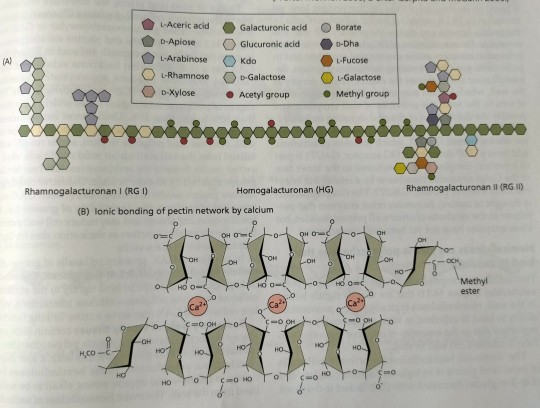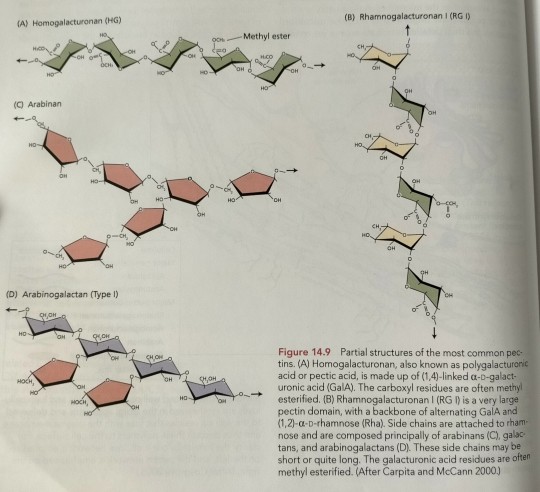#homogalacturonan
Text
Figure 14.10 illustrates a hypothetical scheme for linkage of HG, RG I, and RG II.


"Plant Physiology and Development" int'l 6e - Taiz, L., Zeiger, E., Møller, I.M., Murphy, A.
#book quotes#plant physiology and development#nonfiction#textbook#linkage#homogalacturonan#rhamnogalacturonan#pectin#network#ionic bond#calcium#aceric acid#apiose#arabinose#rhamnose#xylose#galacturonic acid#glucuronic acid#kdo#galactose#acetyl#borate#dha#fucose#methyl
0 notes
Text
Ionic gel formation by HG is important for the adhesion of cells by the middle lamella and makes the primary cell walls less extensible.
"Plant Physiology and Development" int'l 6e - Taiz, L., Zeiger, E., Møller, I.M., Murphy, A.
#book quote#plant physiology and development#nonfiction#textbook#ionic#gel#homogalacturonan#plant cells#adhesion#middle lamella#primary cell wall#cell wall
0 notes
Text
Food for thought of manipulating digestive tract bacteria | BetterButter
Recognizing exactly how dietary fibre nourishes intestine microbes may suggest means to increase health-promoting microorganisms. A method established to pinpoint microorganisms that take in certain sorts of nutritional fibre can progress such efforts.
Certain gut bacteria can increase human health, but it is uncertain exactly how diet regimen could be harnessed to conveniently adjust the structure of intestine microorganisms to boost the degrees of wanted microorganisms. Writing in Cell, Patnode et al. 1 existing a valuable strategy for analyzing communications in between human gut germs and the nutritional fibre that maintains their presence.
Dietary fiber is advertised as part of a healthy and balanced diet worldwide. Dietary fibre encompasses a vast variety of facility particles, most of which are existing in plant cells; amongst them are carbohydrate molecules called glycans, which are immune to digestion by human enzymes. As a consequence, some consumed fiber is secreted unchanged in faeces, whereas many is metabolized by gut microbes.
These microbes have a diverse and incredibly complicated metabolic ability. Microorganisms that express various enzymes for metabolizing fiber can survive and also expand making use of a variety of foods. Some microbial species might compete with each other for the very same food resource, which can decrease the abundance of varieties that compete less successfully. Exactly how might intestine microorganisms be adjusted through human nutritional treatment? The concept of making use of prebiotics-- substances that influence digestive tract microorganisms, consequently profiting the human host-- has been suggested. One such suggestion is to utilize particular fibre sources that offer food for the preferred gut microbes3,4. Determining whether nutritional fiber can promote health in this way needs a sophisticated understanding of the communications that occur when the complicated area of digestive tract microbes comes across a source of fiber.
Previous work5 had actually suggested that moving the intestine germs of human twins that have different body masses (lean and obese) into mice induced a matching difference in the animals' body masses. The kinds of fiber responsible for this effect, as well as exactly how these communicate with certain digestive tract bacteria, was unidentified.
This technique determined, for example, a dose-- reaction result of pea fiber on the relative wealth of Bacteroides thetaiotaomicron in the bacterial populace, as well as a noticable impact of certain kinds of barley fibre (β-glucan and also bran) on the relative abundance of Bacteroides ovatus. These outcomes disclose the uniqueness of the results that various kinds of dietary fibre can have on microbial populations.
To determine the genes required for a specific germs of rate of interest to metabolize fibre, the authors offered mice bacterial strains that were engineered to contain mutations at random websites across their genome, as well as fed the animals various kinds of dietary fiber. When mice got nutritional fiber from fruit peelings (citrus pectin) that are abundant in a kind of particle called methylated homogalacturonan, this led to an increase in the expression of healthy proteins that deteriorate such molecules in the germs Bacteroides cellulosilyticus.
Maybe one of the most original part of this study is the development of man-made 'food bits' consisting of glycan-coated magnetic grains (Fig. 1) that can be provided by mouth to mice and also recovered by applying an electromagnetic field. Patnode et al. used this approach to explore exactly how bacterial species react to various food sources by assessing the extent of glycan destruction in the recuperated grains. When mice that had actually been conquered only with B. bacteroides or cellulosilyticus vulgatus were given food bits covered with pea fibre, the levels of arabinose in the recouped grains were lower than the initial levels, demonstrating that both of these microbial varieties had actually metabolized this molecule in vivo.
1 note
·
View note
Text
Gut bacteria prefer to chow down on certain dietary fibers
Certain human gut bacteria thrive when they feed on specific types of ingredients in dietary fibers, according to a new study.
The work—conducted in mice colonized with human gut bacteria and using new technologies for measuring nutrient processing—is a step toward developing more nutritious foods based on a strategy of targeted enrichment of key members of gut microbial communities.
The researchers identified fibers that selectively increase the abundance of beneficial microbes and tracked down the bioactive components of fibers responsible for their effects. To decipher how members of gut communities compete or cooperate with each other for these fiber ingredients, they also invented a type of artificial food particle that acts as a biosensor for monitoring nutrient processing within the intestine.
Food science revolution
“We are in the midst of a revolution in food science—where the naturally occurring molecules present in various food staples are being identified using advanced analytic tools,” says senior author Jeffrey I. Gordon, a professor of pathology and immunology, developmental biology, and molecular microbiology at Washington University in St. Louis, and director of the Edison Family Center for Genome Sciences & Systems Biology.
“The resulting encyclopedias of food ingredients are providing an opportunity to understand how gut microbes are able to detect and transform these ingredients to products they use to satisfy their own needs, as well as share with us. Cracking the code of what dietary ingredients beneficial microbes covet is a key to designing foods that enhance health.”
Dietary fiber is known to promote health, but typical Western diets are lacking in high-fiber fruits, vegetables, whole grains, and legumes. Fibers contain diverse and complex collections of molecules. The specific components of various fibers that gut bacteria use and confer health benefits are generally not known. Since the human genome possesses a limited arsenal of genes that break down dietary fiber, and many gut bacterial species are chock full of these genes, people depend on gut microbes to digest fiber.
In an effort to understand which types of fiber promote the representation of different types of beneficial microbes in the human gut, and the nature of their active ingredients, the researchers screened 34 types of fiber that the food company Mondelez International provided. Their list included fibers often discarded during food manufacturing, such as fruit and vegetable peels and grain husks.
Gut bacteria are ‘master teachers’
The researchers began by colonizing mice raised under sterile conditions with a collection of gut bacteria species they had cultured from a healthy human. Researchers sequenced the genomes of these organisms to inventory their genes. They fed groups of mice containing this model human gut community initially a base human diet high in saturated fats and low in fiber. Next, the researchers screened 144 derivative diets containing different types and amounts of fiber supplements. The investigators monitored the effects of the added fibers on levels of members of the model gut community, as well as expression of the proteins their genomes encoded.
“Microbes are master teachers,” Gordon says. “The microbial genes that respond to the different fibers provided an important clue as to what kinds of molecules in a given type of fiber a given community member preferred to consume.”
“Our screen identified food-grade fibers that selectively affected different species belonging to a group of bacteria known as Bacteroides,” says first author Michael L. Patnode, a postdoctoral researcher in Gordon’s lab. “Our experiments showed that in pea fiber, the active molecular constituents included a type of polysaccharide called arabinan, whereas in citrus pectin recovered from orange peels, another type of polysaccharide called homogalacturonan was responsible for expansion of the bacteria.”
The researchers uncovered interactions between gut bacterial species that help explain the selective effects of fibers on Bacteroides species. It turns out that some of the Bacteroides in their community directly compete with each other to consume components of dietary fibers, while others defer to their neighbors. Understanding these relationships is important for developing foods that are optimally processed by different microbial populations that live together in the gut, according to the researchers.
To dissect these relationships, Patnode created artificial food particles consisting of different types of magnetic, microscopic glass beads. Each type contained a given fiber-derived polysaccharide bound to the bead’s surface together with a given type of bound fluorescent label. The collection of different bead types was introduced simultaneously into the intestines of different groups of mice colonized with the human gut microbial community—with or without intentional omission of one or more of its Bacteroides members. Researchers then recovered food particles after passage through the intestines of these animals, and the amount of polysaccharide remaining on the particles surfaces was measured.
“These artificial food particles acted as biosensors, allowing us to decipher how inclusion or omission of Bacteroides influenced the community’s ability to process the different polysaccharides present on the different beads,” Patnode says. “Moreover, we were able to monitor fiber degradation in different diet contexts.”
Gordon notes that nutrient-containing artificial food particles could not only be useful as biosensors to define the functional capabilities of a person’s microbial community, but also could help food scientists develop methods for producing more nutritious foods containing different combinations of health-promoting bioactive fiber components.
The study appears in the journal Cell.
Support for the work came from the National Institutes of Health; Mondelez International; and the Chemical Sciences, Geosciences and Biosciences Division of the Office of Basic Energy Sciences of the US Department of Energy (DOE).
Gordon is a cofounder of Matatu Inc., a company characterizing the role of diet-by-microbiota interactions in animal health.
Source: Washington University in St. Louis
The post Gut bacteria prefer to chow down on certain dietary fibers appeared first on Futurity.
Gut bacteria prefer to chow down on certain dietary fibers published first on https://triviaqaweb.weebly.com/
0 notes
Text
The three major pectic polysaccharides, sometimes called pectin domains, are homogalacturonan (HG), rhamnogalacturonan I (RG I), and rhamnogalacturonan II (RG II) (Figure 14.9).

"Plant Physiology and Development" int'l 6e - Taiz, L., Zeiger, E., Møller, I.M., Murphy, A.
#book quotes#plant physiology and development#nonfiction#textbook#pectin#pectic#polysaccharides#homogalacturonan#rhamnogalacturonan#arabinan#arabinogalactan#galacturonic acid
0 notes